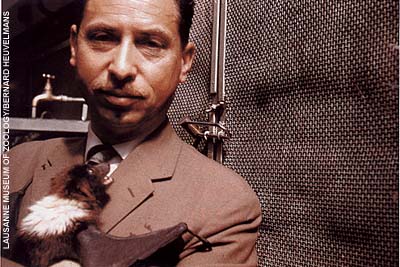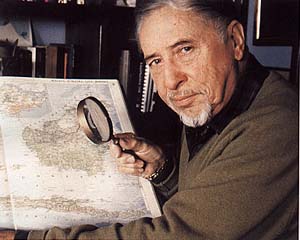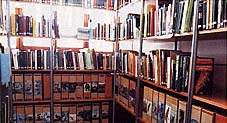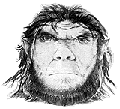Bigfoot Encounters
Bernard Heuvelmans R.I.P.
© Fortean Times (FT153), December 2001
died on 24 August 2001, aged 84.

Portrait of the artist as a young cryptozoologist: Heuvelmans,
early in his career, poses
with a friendly flying fox.
In 1948, Heuvelmans discovered a Saturday Evening Post article, in which zoologist Ivan T. Sanderson sympathetically discussed the evidence for the possible survival of dinosaurs into the present. It provided a focus for his interests and inspired him to seek evidence in scientific and literary sources. Within a few years he had amassed so much material that he was ready to write a book. And what a hook... Sur la piste des bêtes ignorées — published in 1955 and better known in its 1958 English translation On the Track of Unknown Animals — was huge in scope and weight. Almost five decades later, the book remains in print, with more than one million copies sold in various translations and editions, including one in 1995, with an updated introduction.
The impact of the book was far-reaching. As one critic remarked at the time, "Because his research is based on rigorous dedication to scientific method and scholarship and his solid background in zoology, Heuvelmans' finding are respected throughout the scientific community." Soon he was engaged in massive correspondence as his library and other researches continued. In the course of letter-writing, he invented the word 'cryptozoology' (it does not appear in On The Track). That word saw print for the first time in 1959, when French wildlife official Lucien Blancou dedicated a book to the "master of cryptozoology." Over the subsequent decades, Heuvelmans corresponded with cryptozoologists all over the world. By the 1960s, most in the field had improved on Blancou's phrase in honour of Heuvelmans, who was now hailed as the "Father of Cryptozoology."
 |
| On The Track Of Unknown Animals: The 'father of cryptozoology' contemplates another trip. |
Heuvelmans was asked to examine the 'Yeti skullcap' brought back by Sir Edmund Hillary's 'World Book' expedition of 1960. He was also one of the first to declare it was a ritual object made from the skin of a serow; a small goatlike animal found in the Himalayas. Heuvelmans' extensive files on the Slick expeditions remained mostly unpublished until he contributed them for inclusion in the 1989 book, Tom Slick and the Search for the Yeti.
On the Track of Unknown Animals was concemed exclusively with land animals. The second of Heuvelmans' landmark works to be translated into English, In the Wake of the Sea-Serpents (1968), was a synthesis of two smaller books on the 'Great Unknowns' of the ocean and the enigmatic giant squid.
In 1968, Heuvelmans visited Minnesota (at Sanderson's invitation) to examine what was claimed to be the cadaver of a an unknown 'primitive' hominoid preserved in a block of ice, the subject of his L'homme de Neanderthal est toujours vivant (with Boris Porshnev, 1974). Other books, not yet translated into English, include works on surviving dinosaurs and relict hominids in Africa. Heuvelmans' Centre for Cryptozoology, established in 1975, was first housed near Le Bugue in the south of France, but in the 1990s moved to Le Vesinet, closer to Paris. It consisted of his huge private library and his extensive investigation files. He was elected president when the International Society of Cryptozoology was founded in Washington DC, in 1982, and held the position until his death. He also was involved with the British Columbia Scientific Cryptozoology Club and other efforts for active cryptid studies globally. In a 1984 interview, he expressed the desire to write a 20-volume cryptozoology encyclopaedia, a project that, unfortunately, never came to fruition.
Through the years, without fantare, Heuvelmans journeyed from the shores of Loch Ness to the jungles of Malaysia, interviewing witnesses and examining the evidence for unknown creatures. He produced a few articles along the way and, infrequently, gave news interviews. But, beginning in the 1990s, he began to avoid media events. Although he had made a French television pogamme on natural history mysteries over two decades before, he routinely refused most mainstream interviews in the last decade of his life. For example, when a television network asked in 1994 and I1995, to tape an interview with Heuveltnans about the 'Minnesota Iceman', he would not come to America to do it and then refused to be filmed in France. He also avoided formal meetings; when in February 1997, he was awarded the Gabriele Peters Prize for Fantastic Science at the Zoological Museum of the University of Hamburg, Germany, he was unable to appear to collect the prize of 10,000 Marks (about $6000) and sent his friend, journalist and crytozologist, Werner Reichenbach, to accept it on his behalf.
Heuvelmans' health began to fail seriously in the mid-1990s and he tried, with a sense of urgency, to complete his planned multi-volume encyclopaedia. By 2001, many of us were dismayed to find he was mostly bedridden and in very poor health. In his waning years, he became preoccupied with the thought that no one would credit him for what he had done. He need not have troubled himself; he will always be remembered as the 'Father of Cryptozoology' for his lifelong dedication to the new science, as well as for his personality and scholarship. His unique cryptozoological archive is now with the Museum of Zoology of Lausanne in Switzerland.
 |
|
 |
Cabinet of Curiosities: Materials in the Heuvelmans Archive at the Museum of Zoology, Lausanne, including the famous "yeti scalp." |
The Museum of Zoology, Lausanne, welcomes bona fide researchers to the Heuvelman's Archive by appointment only.
1916: born, Le Havre, France.
1955: first book published (Sur la piste des bêtes ignorée).
1960: examined 'Yeti skullcap'.
1962: visted Loch Ness
1967: visited East and Southern Africa.
1968: visited Minnesota to study Iceman.
1969: visited Central America.
1975: Centre for Cryptozoology established in Le Buque.
1993: visited Malaysia
1997: awarded the Gabriele Peters Prize.
2001: died on 24 August.

